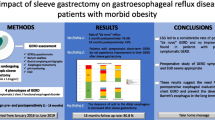Background
The BioEnterics intragrastric balloon (BIB) has been successfully used for treatment with BMI > 35 or BMI > 40. Gastroesophageal reflux (GER) symptoms are sometimes reported to occur and/or to worsen in patients with BIB, with a variable onset of erosive esophagitis (EE). The aim of this study was to investigate the prevalence and the severity of esophagitis after BIB placement.
Methods
121 patients (93 F, 28 M, mean age 45 (19–65), mean BMI 41.5 (30–63.5) were studied. Patients with severe esophagitis (grade C-D Los Angeles (LA) classification), gastric or duodenal ulcers were excluded from the BIB treatment. After BIB placement, proton-pump inhibitors (PPI) were administered in the first month to each patient. The BIB was removed after 6 months. The presence of EE and related severity by LA classification were recorded.
Results
Before BIB insertion, 18 patients (15%) showed mild EE (16 grade A and 2 grade B). After BIB removal, EE was observed in 22 patients (18.2%): 11 grade A, 7 grade B, 4 grade C-D. The difference in the prevalence of EE after BIB was statistically significant (Wilcoxon’s test P = 0.030).
Conclusion
EE prevalence was significantly increased after BIB placement. We suggest that EE due to enhanced GER could be considered as an adverse effect of such treatment.We therefore recommend maintaining intragastric acid suppression with PPIs during the 6 months of BIB placement.
Similar content being viewed by others
References
World Health Organization. Obesity: preventing and managing the global epidemic. Report a WHO consultationon obesity. WHO/NUT/NCC98.1 WHO Technical Support Series, WHO Geneva; 1998: 1–276.
Allison D, Fontain K, Manson J et al. Annual deaths attributable to obesity in the United States. JAMA 1999; 1282: 1530–8.
Van Italie TB. Obesity: adverse effects on health and longevity. Am J Clin Nutr 1979; 32; 2723–33.
Mokdad AH, Bowman BA, Ford ES. The continuing epidemics of obesity and diabetes in United States. JAMA 2001; 286: 1195–2000.
Fontaine KR, Redden DT. Years of life lost due to obesity. J Clin Endocrinol Metab 2004; 89: 2522–5.
Fender JR. Epidemiology of obesity in the United States. Gastroenterol Clin North Am 2005; 34: 11–3.
Neiben OG, Harboe H. Intragastric balloon as an artificial bezoar for treatment of obesity. Lancet 1982; 1: 198–99.
Mathus-Vliegen EM, Tytgat GN. Intragastric balloon for treatment-resistant obesity: safety, tolerance and efficacy of 1-year balloon treatment followed by 1-year balloonfree follow-up. Gastrointest Endosc 2005; 61: 19–27.
Gostout CJ, Rajan E. Endoscopic treatments for obesity: past. present and future. Gastroenterol Clin North Am 2005; 34; 143–50.
Shah A, Uribe J, Katz P. Gastroesophageal reflux disease and obesity. Gastroenterol Clin North Am 2005; 34; 35–43.
Suter M, Dorta G, Giusti V et al. Gastro-esophageal reflux and esophageal motility disorders in morbidly obese patients. Obes Surg 2004: 14: 959–66.
Wahlen CH, Bastens B, Herve J. The BioEnterics intragastric balloon (BIB): how to use it. Obes Surg 2001; 11: 524–7.
Doldi SB, Micheletto G, Perrini MN. Treatment of morbid obesity with intragastric balloon in association with diet. Obes Surg 2002; 12: 583–7.
Evans JD, Scott MH. Intragastric balloon in the treatment of patients with morbid obesity. Br J Surg 2001; 88: 1245–8.
Eynden FV, Urbain P. Small intestine gastric balloon impaction treated by laparoscopic surgery. Obes Surg 2001; 11: 646–8.
Pretolesi F, Redaelli G, Papagni L. Intragastric balloon for morbid obesity causing chronic gastric dilatation. Eur Radiol 2001; 11: 588–9.
Armstrong D, Bennett JR, Blum AL et al. The endoscopic assessment of esophagitis: a progress report on observer agreement. Gastroenterology 1996; 111: 85–92.
Wilson LJ, Ma W, Hirschowitz B. Association of obesity with hiatal hernia and esophagitis. Am J Gastroenterol 1999; 94: 2840–4.
Mercer CP, Wren SF, Da Costa LR et al. Lower esophageal sphincter pressure and gastroesophageal pressure gradients in excessively obese patients. J Med 1987; 18: 135–46
Lagergren J, Bergstrom R, Nyren O. No relation between body mass and gastroesophageal reflux symptoms in a Swedish population-based study. Gut 2000; 47: 26–9.
Mercer CD, Rue C, Hanelin L. Effect of obesity on esophageal transit. Am J Surg 1985; 149: 177–81.
Zacchi P, Mearin F, Humbert P. Effect of obesity in gastroesophageal resistance to flow in man. Dig Dis Sci 1991; 36: 1473–80.
Fisher BL, Pennathur A, Mutnick JL. Obesity correlates with gastroesophageal reflux. Dig Dis Sci 1999; 44: 2290–4.
Mathus-Vliegen EM, Tytgat GN. Gastroesophageal reflux in obese subjects: influence of overweight, weight loss and chronic gastric balloon distention. Obes Surg 2004; 14: 539–44.
Hirsch DP, Mathaus-Vliegen EM, Dagli U et al. Effect of gastric distension on lower esophageal function and gastroesophageal reflux. Am J Gastroenterol 2003; 98: 1696–704.
Author information
Authors and Affiliations
Corresponding author
Rights and permissions
About this article
Cite this article
Rossi, A., Bersani, G., Ricci, G. et al. Intragastric Balloon Insertion Increases the Frequency of Erosive Esophagitis in Obese Patients. OBES SURG 17, 1346–1349 (2007). https://doi.org/10.1007/s11695-007-9239-3
Received:
Accepted:
Published:
Issue Date:
DOI: https://doi.org/10.1007/s11695-007-9239-3




